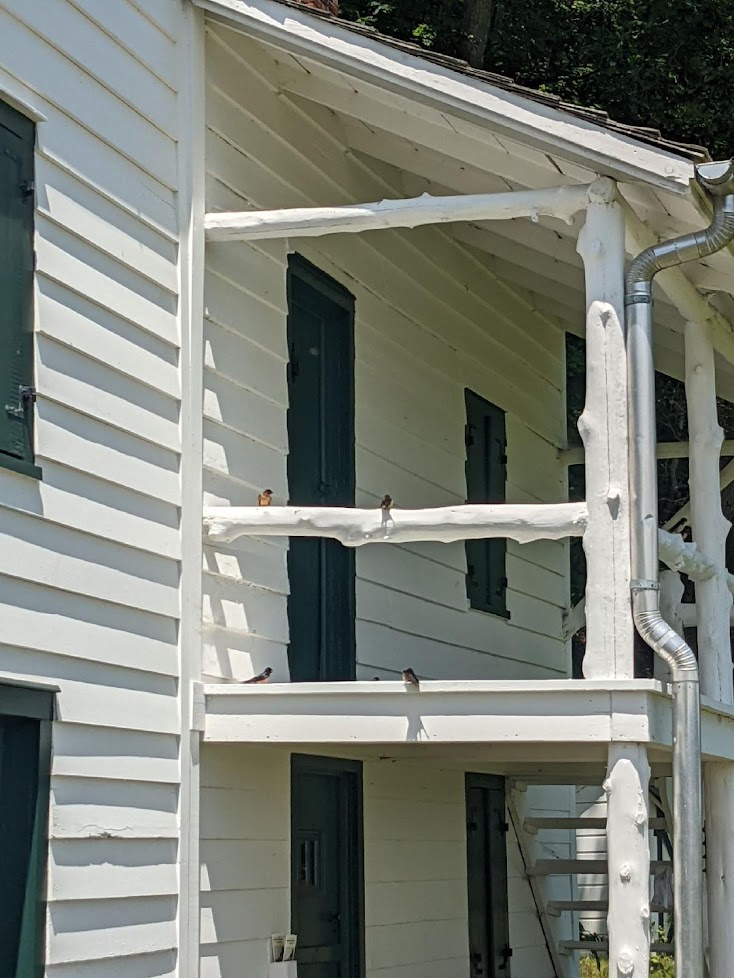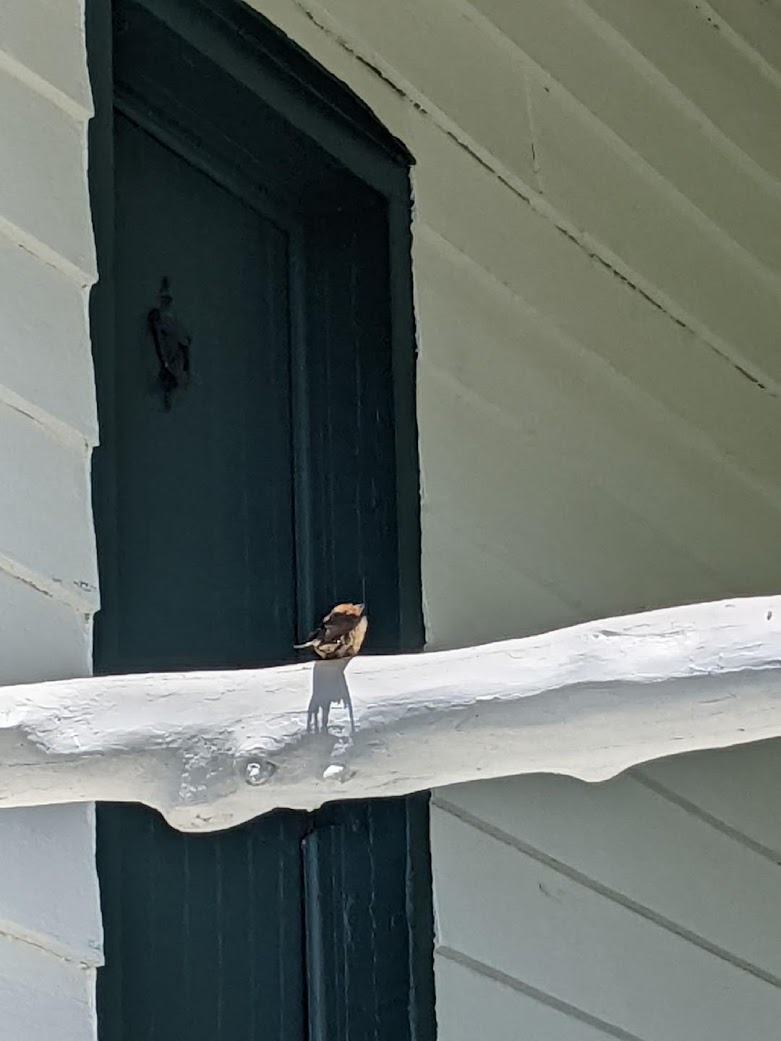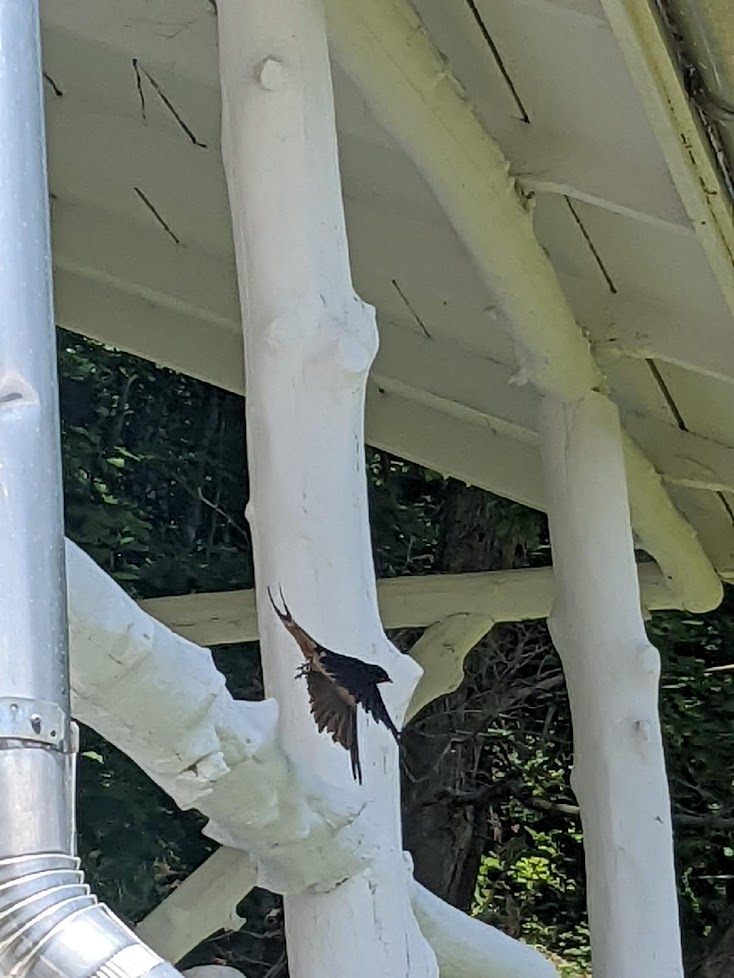Transients
A “Cliff Notes” Story
April 2018
Of all the delights of spring we might long for through the winter, the return of the barn swallows to our riverfront picnic areas is among the sweetest. By June, these little aerialists — not much larger than sparrows — have become true show-stoppers, as they cavort above the lawns and dodge behind tree trunks and pilings, up and over picnic tables and branches, back around the lawn again and out over the water, constant blurs of motion. We’ve watched from the porch of the Kearney House on busy weekends, the picnic area bustling with children running and playing, grills filling the air with mouth-watering smoke, and seen the swallows scoot through and between it all like it was nothing but wide open space they had all to themselves. Stand still in the open for a minute or two, and one or two of them may buzz just inches from your head.
There’s a purpose to the show, of course: they’re dining on the fly, snatching insects from thin air. It’s mostly flies that they feed on, though they’ll also grab bees and wasps and moths, often skimming just over the ground and water — they’ll even scoop up a drink in flight — then climbing sometimes to above the treetops.
It can be maddening to try to get a good look at one — let alone a photo. But when you do see one sitting still, you see a diminutive, pretty bird with a slate-blue back and crown, gray wings and tail, buff-colored belly, and a cinnamon-orange throat and crown. (Both sexes have similar markings, but the males are more vibrant.) Roosting, the swallow tucks herself into a compact cone that tapers from her broad “shoulders” to the pointed tips of her tail. Off her roost, she reveals her curved, pointed wings and the deeply forked tail that provide her with all that airborne agility.
The barn swallow (Hirundo rustica) is found in six subspecies in Europe, Asia, Africa, and the Americas. Like its cousins, the North American subspecies (H. r. erythrogaster), which breeds from Alaska to southern Mexico, has adapted to human development — flourishing among us — building their nests on human structures such as barns, with their eaves and rafters, or on the crossbeams under bridges and wharfs. At both boat basins in the park, they build dozens of nests each year under the docks — and so their abundance in the neighboring picnic areas.
Odds are, the swallows we see here along the Palisades in the spring and early summer were also hatched here, last year or a year or two before that (the barn swallow’s average life span is about four years). Now they’ve come back to make nests of their own.
In between, as the Northeastern winter piles its snow and ice on the past year’s fallen leaves, H. r. erythrogaster, by their many thousands, fly south, their tiny wings taking them on an epic journey down the continent, between the seas on either coast of Central America, and on to South America.
When spring at long last returns to our corner of the world, bare twigs and branches, in a matter of just a few short weeks, explode into riots of green, jungle-like growth — and the air fills with winged insects again. Male and female barn swallows will pair off to explore for nest sites together, hovering above potential sites as they narrow down their choices. Once the site has been selected, the male will vigorously fend off other swallows, even “wrestling” them to the ground. Even so, when predators such as gulls or crows are nearby, groups of swallows will band together to “mob” the intruders and try to chase them away.
The male and female will build the nest together, each taking pieces of mud in their beaks and mixing it with grass stems to make tiny, brick-like pellets they form into a cup. They line the inside first with grass, then with feathers. The female will lay between three and seven creamy-colored, spotted eggs, and both parents will take turns sitting on them for around two weeks. Once hatched, the nestlings stay in the nest for another two to three weeks before they fledge, and the parents will sometimes have a second brood. (The nesting process is not easy, nor is it safe. We had a nest on a porch rafter at the Kearney House last year with several eggs in it, the parents warning us with their wing beats to stay clear. One morning the eggs were gone. We figured it was the work of a raccoon — or perhaps the big black rat snake we’d been seeing around — someone who wanted eggs for breakfast.)
For the newly fledged barn swallows, there is no time to waste. They must fatten up and get ready to journey south with their parents, across all those miles of open air, some all the way to across the equator. Come August, “our” barn swallows, with all their antic life in the air above the picnic areas, will be a memory — except for a handful of their kin you may occasionally see passing high overhead, flying from nesting sites to the north of us, bound for faraway lands.
– Eric Nelsen –




